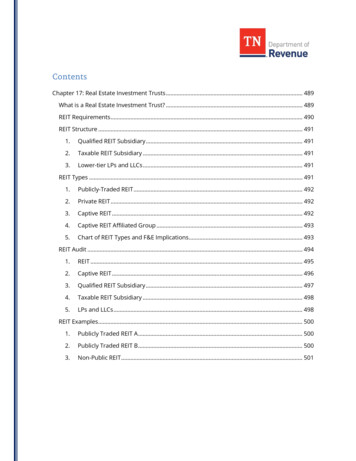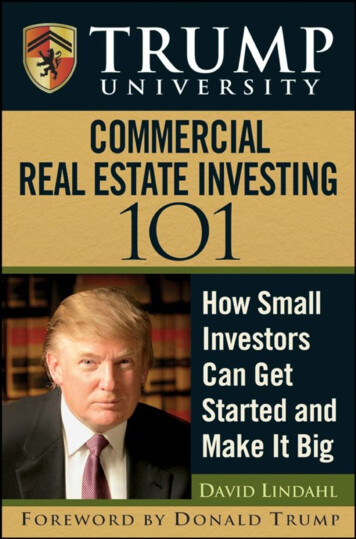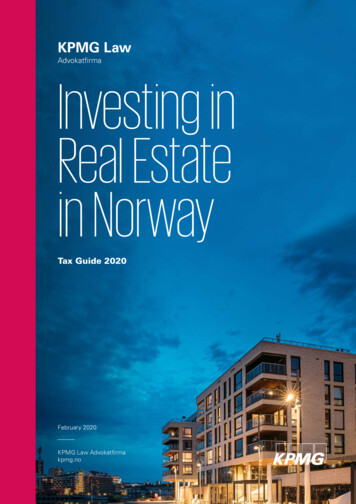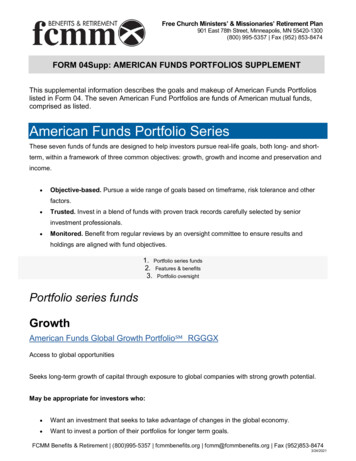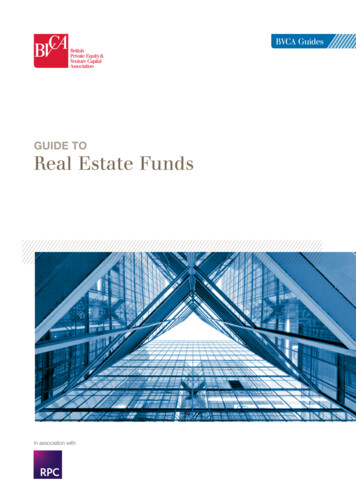
Transcription
BVCA GuidesGUIDE TOReal Estate FundsIn association with
ComplexissuesSmartlyresolvedA fresh perspective.We combine years of funds experience with a modern approach to supportingyour business ambitions. We work with you to understand your strategy.We cut through complexity. We strip back inefficiency.We deliver value. Always.And all with smart people our clients actually enjoy working with.smarter lawsmarterlaw.comWinner – Law Firm of the Year – The Lawyer Awards 2014Number 1 out of 106 firms surveyed in Legal Week’s Client Satisfaction Report
ContentsIntroduction4Foreword5A comparison between real estate funds and joint ventures6Investor protection – current trends in real estate funds9Tax structuring and recent developments11Finance – some key trends for real estate funds14Key exemptions under AIFMD16Structuring issues for real estate fundsXxxxxxxn Q&A with James Jacobs, Managing Director, Lazard18n Q&A with Charlie Vaughan-Lee, CEO, Student Cribs203
IntroductionWelcome to the BVCA Guide to Real Estate Funds, the latest inour series of guides into business sectors, investment strategiesand international markets.Private equity and real estate have a long history, stretching back to well before the financialcrisis as the maturing asset class sought to diversify into new areas. It was simple tounderstand the rationale. Real estate, at least in the opening few years of the 21st century,offered a relatively low-risk, stable investment profile and was well-suited to the privateequity model.In recent years it is a sector which has experienced huge growth, moving from a subsetof private equity to an asset class in its own right. And with this has come greaterdiversification; there is now a variety of different strategies, fund structures and firmsoperating in the real estate space.As a result, it is a very competitive environment to be in. Institutional investors are continuingto pump in money. Over US 15 billion was raised for European funds in the first half of 2015,US 60 billion globally. According to data provider Preqin there is a record US 254 billionof dry power available. This last figure is obviously partly driven by the attractiveness of thesector, but it is also a reflection of the increased competition for assets.This guide provides an overview of a hugely dynamic market, covering market trends,tax structuring, regulatory developments and more. It is aimed at anyone looking to gaingreater insight into private equity real estate funds and investment, and contains a wealth ofinformation of value to both the new entrant and the experienced investor.I hope you find this guide both interesting and insightful, and I would like to thank RPC for itssupport.Tim HamesDirector GeneralBVCA4IntroductionReal Estate Funds
ForewordSeven years on from the inception of the worst financial crisis wehave ever seen, global capital continues to search out safe havenswhich guarantee return of capital as well as return on capital.For real estate markets in primary cities such as New York, London and Hong Kong, this has drivenup asset prices to historically high levels, with pricing further supported by quantitative easing bythe world’s principal central banks.Another trend amongst many global investors, such as sovereign wealth funds and insurancecompanies, is to seek to identify investments which generate higher returns so as to match futurelong-term liabilities and this has prompted a return to more opportunistic investing with a returnprofile higher up the risk curve.With those trends in play, and with a surplus of equity and debt capital washing around the system,it is clear that the real estate markets in much of the UK and the US, some parts of Europe, andin key cities in Asia, have normalised; and this is evidenced by real estate teams in many large lawfirms being kept consistently busy.In terms of legal structures being used to deploy capital into real estate markets, we are nowseeing ever greater fragmentation and unpredictability in terms of how deals are structured.Whereas prior to the financial crash many were adopting a typical private equity-style fund modelwith 2 and 20 fees payable, today we are seeing a broad spectrum of structures being used acrossdifferent markets and risk profiles, from straight joint ventures and co-investment transactions(involving two equity investors), club and consortia deals (involving three to perhaps nine equityinvestors), through to fully fledged funds (involving say not less than 10 equity investors). And withclub deals and funds, the assumption that equity investors broadly invest on the same basis andwith the same economics is being gradually eroded, with varying commercial deals being struckbetween the different investors. This is making the world of real estate funds a much more vibrantplace to inhabit.In this guide to real estate funds, we cover the following topics:nnnnnA comparison between funds and joint ventures;The principal protections investors seek when investing into real estate funds;The latest tax developments;Key trends in financing;An analysis of the frequently cited joint venture and co-investment exemptions under theAlternative Investment Fund Managers Directive (AIFMD).Also included in this guide is a Q&A on current real estate fund raising trends, contributed byLazard, which is one of the leading private placement agents in the real estate fund raising market,and another Q&A from Student Cribs, one of the UK’s emerging real estate managers focusing onstudent accommodation.We very much hope you find this guide engaging, readable and informative.Anthony ShatzPartner, Head of Investment FundsForeword5
rriederestnershipised Operatorager/AdviserrA comparison betweenreal estate funds andjoint venturesInvestor (A)Investor (B)Investor (A)Investor (B)50% shareholding50% shareholding50% limitedpartner interest50% limitedpartner interestSince the 2008 crash, real estate funds have adopted ever morediverse structures to take account of market dynamics and drivers.FCA AuthorisedOperatorGeneral PartnerTo a large extent the structure is driven by the Limitedn Club or consortia transactions,similar to trueOperating AgreementPartnership funds in that the manager has discretion tonumber of equity investors participating in the(LimitedPartnership Deed)expend investor capital in accordancewithfund, such that one could categorise themarketAssetManagerNomineesa specific investment policy,but where theinto the followingbroad categories:Beneficial titlenumber of financial investors is say betweenDevelopmentn Pure joint ventures, where twoparties comethree and nine, and wherea number ofLegal titleAsset/DevelopmentManagerManagementmay have enhanced controltogether to develop a specific asset or seriesthose investorsAgreementor management rights. See Figure 3of assets. See Figure 1 and 2.dsthipartnerFigure 1: An indicative corporate joint ventureInvestor (A)nagerInvestor (B)50% shareholding50% shareholdingAssetManagerFCA AuthorisedOperatorJV anageredstshipFigure 2: An indicative joint venture structure utilising a limited partnershipd Operatorr/AdviserrInvestor (A)Investor (B)Investor (A)Investor (B)50% shareholding50% shareholding50% limitedpartner interest50% limitedpartner interestFCA AuthorisedOperatorGeneral PartnerLimitedPartnershipOperating Agreement(Limited Partnership Deed)AssetManagerNomineesBeneficial titleLegal ntManagernererReal Estate Funds6Investor (A)Investor (B)
n True funds, whether open-ended or closedended, where the number of passivefinancial investors in the fund is say 10 ormore, and the manager has discretion toexpend investor capital in accordance with aspecific investment policy. See Figure 3n Co-investment transactions, where investorsin a fund increase their exposure to aspecific fund asset by committing additionalco-investment equity capital, usually on apassive basis, and often where the equityis ‘syndicated’ after the original acquisitiontakes place. See Figure 4Real estate funds often have many similarities toprivate equity fund models and, as with privateequity funds, the limited partnership remains themost common structuring vehicle in the UK.The limited partnership allows investors to investtogether on a scale that they may not be ableto achieve alone, to diversify risk by poolingcapital with other investors and to access themanagement skills of fund managers. Realestate funds also provide investors with theadded attraction of tax efficient structuring andlimited liability of investors.As with private equity funds, real estate fundmanagers are often paid a managementfee designed to cover the fund manager’soverheads and a performance fee (known as the‘carried interest’ or ‘promote’) which is intendedto incentivise managers to enhance the fund’sperformance, although in this market there areoften large discrepancies between the feescharged by different funds.Light touch legislative constraints on limitedpartnerships allow for considerable flexibilityfor parties to negotiate appropriate commercialterms between themselves. The AlternativeInvestment Fund Managers Directive, however,has clearly added a further level of regulation forinvestors and managers to comply with.Figure 3: An indicative real estate fund/clubInvestorsCarried interestCarried interestInvestorsGeneral PartnerLimitedPartnershipOperating AgreementCarriedInterestPartnershipCarriedInterest OperatorFCA AuthorisedPartnershipInvestor (A)General PartnerNominee(s)LimitedPartnershipBeneficial titleOperating AgreementAsset/DevelopmentManagement AgreementLegal titleBeneficial titleNominee(s)Asset/DevelopmentManagement AgreementLegal titleFCA Authorised OperatorFund Manager/AdviserrFund Manager/AdviserrInv50% shareholding50% sInvestor (A)Investor50% shareholding50% sharehoGeneral PartnerGeneral PartnerNomineesFigure 4: An indicative co-investment structure(LiNomineesBInvestors50% shareholding50% shareholdingInvestors50% shareholding50% shareholdingCo-investmentvehicleLegal titleFundFundCo-investment rtnershipGeneral PartnerLegal titleGeneral PartnerInvestor (A)Fund ManagerInvestor50% shareholdingFund Manager50% shareholdingFCA AuthorisedOperatorFCA AuthorisedOperatorA comparison between real estate funds and joint ventures7(A)
Selecting the right structureThe following table sets out some of the key characteristics of joint ventures, funds and co-investment transactions.8Joint VenturesClosed-ended fundsOpen-ended fundsCo-investmentsManagement andcontrolJoint venture partiesin a real estate projectretain management of thejoint venture through theappointment of directorsto the board. Deadlocksituations will often be putto determination by senioremployees of each jointventure party or, sometimes,to industry experts (such aschartered surveyors).Alternatively, or if there isa breakdown in relationsbetween participants, a buyoutprovision may be appliedwhereby a party bids to buyout all of the other party’s jointventure interest.Investors rely on theknowledge and expertiseof the manager to produceenhanced returns on theirinvestment and are thereforelargely passive in themanagement of the fund(unless for instance theyhave a seat on the advisorycommittee).Investors rely on theknowledge and expertiseof the manager to produceenhanced returns on theirinvestment and are thereforelargely passive in themanagement of the fund(unless for instance theyhave a seat on the advisorycommittee).One or more investors willrely on the knowledge andexperience of the managerto operate the co-investmentvehicle and take allmanagement decisions with aview to producing enhancedreturns, usually in connectionwith a specific real estateasset.DurationJoint venture parties arefree to set whatever term ofthe joint venture they deemappropriate. They will be ableto extend or shorten the termby mutual consent.A term of 8-12 years iscommon in a closed-endedreal estate fund.Often the manager will havediscretion to extend theterm of the fund by up totwo additional years (withthe consent of the advisorycommittee) if circumstancesrequire an extended fund termto ensure enhanced returns forinvestors.Open-ended funds havean indefinite term, but witha provision that enablesinvestors representing acertain percentage of the fundto wind-up the fund at a futuredate.In a similar manner to aclosed-ended fund a coinvestment will sometimeshave a fixed term and themanager may have theopportunity to extend the termof the co-investment in certaincircumstances (e.g. for twoyears).Alternatively, the coinvestment will have no fixedterm and will terminate at suchtime as the parties agree.DefaultJoint venture partieshave freedom to imposewhatever consequencesare commercially agreeableshould a party fail to advancenecessary capital to the jointventure on demand (so longas the terms are not punitive).The forced sale of a party’sjoint venture interest at adiscount is not uncommon,as is a provision enabling thenon-defaulting party to fundthe defaulted amount at apenal rate of interest.Investors are subject tosignificant consequencesfor failing to fund following adrawdown request from themanager. Typically investorswill be subject to interest ofup to 10% for late payment,and forfeiture of the investor’sstake in the fund at a discountof up to 20% is common.Investors are subject tosignificant consequencesfor failing to fund following adrawdown request from themanager. Typically investorswill be subject to interest ofup to 10% for late payment,and forfeiture of the investor’sstake in the fund at a discountof up to 20% is common.The consequences of aninvestor default are severeand can include forfeiture ofits co-investment interest,distributions may be retained,or part of an investor’s interestmay be sold or redeemed onsuch terms as the managerdetermines is appropriate.ExitJoint venture partieswill often agree specificprovisions around exit suchas incorporating pre-emptionrights and drag/tag alongrights for minority joint ventureparties.Closed–ended realestate funds offer limitedopportunities for investors toexit the fund prior to the endof the fixed term. However,secondary transactions wherethe investor sells its interest inthe fund is widely permitted,subject to the consent of themanager.Open-ended funds areinherently more liquid andinvestors may sell, transfer orredeem their interests in thefund. However, redemptionperiods and contractuallimits on the amount ofan investment that can beredeemed or transferredwithin a given period of timemean that investments inopen-ended funds are not asliquid as investors sometimesexpect.The transfer of an investor’sinterest in the co-investmentvehicle will often be subjectto the absolute consent of themanager.EqualisationGenerally not applicableInvestors investing after theinitial closing date will berequired to advance additionalsums in addition to theirinvestment to ensure thatthey are in the same financialposition as the investorsadmitted on the first closing.Such amounts, and an amountequal to the preferred returnon such amount, will be paidto the existing investors prorata to their respective fundinterests.Usually the same or similarprovisions to closed endedfunds.Not applicable as it is rare foradditional closings to be heldand/or additional partnersadmitted to co-investmentvehicles.Admission of additionalinvestors will be at themanager’s discretion.Side lettersgrantingenhanced orspecific rightsto particularinvestorsNot applicableOften usedUsed, but not as frequentlyas in closed-ended fundsbecause of the inherently moreliquid nature of open-endedfunds.Not applicableReal Estate Funds
Investor protection –current trends in realestate fundsConcern over downside scenarios and investment risks are now at theforefront of investor thinking.Institutional investors negotiating the terms oftheir cornerstone investments in real estatefunds now see investor protection mechanismsas key points of negotiation. The followingkey areas of negotiation between a managerand investors are indicative of a trend towardsenhanced investor protection in real estatefunds.Participation and controlSince the global financial crisis, real estatefund investors have sought to take a greaterdegree of control of how their investmentsare managed. Advisory committees areincreasingly common with ever greaterparticipation by investors. A seat on the fund’sadvisory committee is very often a ‘must have’for all but the smallest investors.Conversely, however, investors do not wantadvisory committees to become too large asthey become cumbersome and an investor’sInvestor protection – current trends in real estate fundsinfluence becomes diluted. This inherentcontradiction is often solved by capping themaximum number of members of an advisorycommittee and insisting that membership ispurely a question of capital commitment to thefund.Key person clauses are also becomingincreasingly common as the managementskills and industry experience of specificfund managers and their teams are vitalconsiderations in an investor’s decisionto invest. An example of how investorparticipation has grown in recent years is thenow common requirement of advisory boardconsent to the appointment of a replacementkey person by the fund manager.Corporate governanceCorporate governance issues, specificallythe composition of the fund’s board, havealso become forefront in investors’ minds.9
Ensuring that the board, particularly where amajority of the directors are located offshore,has sufficient knowledge and expertise to fullyunderstand the fund’s investment strategy,investment decisions and the underlying assetsis essential.“ Compensation pay-outs to deposed general partners,however, can be a key consideration for investorsbefore exercising their entitlement to remove thefund manager”And the independence of a fund’s board ofdirectors remains crucial to investors to ensureimpartial decision making in the best interestsof investors.Escrow accounts and claw-backSince 2008, investors have been increasinglyreluctant to permit fund managers to be paidcarried interest without ensuring appropriateinvestor protections are in place, and fundmanagers are increasingly prepared to acceptsuch requirements from investors as marketnorms.Accordingly, escrow accounts and/or clawback mechanisms are increasingly common inreal estate funds as they provide investors withrecourse against the carried interest partiesshould, for example, one investment greatlyoutperform expectations and other investmentsunderperform. An escrow of 50% of carry isquite typical.Removal of the fund manager no-fault divorceThe ability of investors, often by 75% approval,to remove a fund manager even if they are notin breach of the fund agreements, remainsan important form of investor protection.Compensation pay-outs to deposed generalpartners, however, can be a key considerationfor investors before exercising their entitlementto remove the fund manager. As a result,removal of the general partner without causeremains an extremely unusual occurrence inreal estate funds.10TransparencyNot only are investors looking for enhancedprotection in terms of their investment but theyare now entitled to increased transparencythanks to the Alternative Investment FundManagers Directive (AIFMD).While the parties to joint venture agreementshave total transparency as to their commercialterms, real estate funds have beencharacterised by confidentiality. Secretive sideletters and most favoured nations clauses havehistorically brought a degree of secrecy to realestate funds.Preferential fee breaks (including fee holidays),as well as guaranteed positions on advisoryboards commensurate with the size of aninvestor’s capital investment, are common inreal estate funds and only investors with equalor greater investments are entitled to benefitfrom, or have disclosure of, such preferentialtreatment.Thanks to the AIFMD, fund investors areincreasingly aware of the obligations onmanagers to treat investors fairly and todisclose the nature of preferential treatment topotential investors in EU funds. How this dutywill be implemented by different fund managersin practice remains to be seen.Real Estate Funds
Tax structuring and recentdevelopmentsReal estate funds need to be structured in such a manner so asto ensure there is little or no tax at the fund level, and that thedownstream structure is efficient in keeping local tax on rentalincome and capital gains to the minimum.There are a number of different options to beconsidered when setting up a fund vehicleto invest in real estate, and the tax treatmentis a key factor influencing the choice ofstructure. Tax transparency at the fund level isa key driver, providing pension funds and lifeinsurers, as well as investors from a variety ofjurisdictions, the opportunity to invest alongsidetaxable corporates and individuals withoutcompromising their own tax status. Two ofthe most popular investment vehicles for UKreal estate are the limited partnership and theoffshore unit trust, both of which are oftenused in conjunction with subsidiary specialpurpose vehicles.Limited partnership structuresLimited partnerships (LPs, often English butsometime established offshore) remain a widelyused fund vehicle. More recently limited liabilitypartnerships (LLPs) have become more popularas they have a separate legal personality,unlike LPs, although LLPs are not efficient forUK pension vehicles as the income and gainsderived from property investment LLPs are nottax exempt.LPs and LLPs are, from a UK tax perspective,transparent and hence are not subject to taxon their income and gains. Tax transparency inother jurisdictions will, of course depend uponlocal rules, although LPs are usually transparentin most, and whilst LLPs may not be regardedas such in some countries, from a US taxperspective LLPs can ‘check the box’ to betreated as tax transparent partnerships.UK tax resident investors are subject to tax ontheir share of any net income (including propertyrental income) and on their share of any gainsarising to the partnership in accordance withtheir profit sharing rights under the partnershipagreement. Non-UK investors are generally onlyTax structuring and recent developmentssubject to UK income tax on their share of anyUK source income of the fund, with non-UKsource income and all capital gains typicallynot subject to UK tax. Where there are non-UKinvestors in the partnership that is invested inUK property then tax must be withheld at 20%from their share of the rent as it arises, althoughit is common to apply under the non-residents’landlord scheme (NRLS) for gross payments tobe made.As the income and gains are taxed in thepartners’ hands as they arise to the partnershipthere is no further tax to pay when thepartnership distributes its profits.Although some partnership funds will investdirectly into the underlying real estate, it iscommon for funds to use wholly ownedsubsidiary companies (SPVs) to acquire andhold each investment. Such SPVs are typicallyset up and tax resident in jurisdictions such asJersey or Guernsey. There are various reasonswhy such SPVs may be used. One of theseis to assist in the tax efficient funding of eachunderlying property so as to ensure that taxdeductible interest payments can be generatedfor offset against the rental income. Anotheris to provide the option of selling the SPVrather than the property on exit, which may bemore tax efficient for certain investors, and incertain jurisdictions, than selling the property.Furthermore in some jurisdictions this mayreduce or eliminate stamp or transfer taxes (e.g.in respect of UK properties this prevents UKstamp duty land tax (SDRT) at rates of up to15%) arising on the sale consideration.As the SPVs are typically located in jurisdictionsin which no local tax is paid, the only taxincurred on income will be on the rental incomein the jurisdiction of the property. For UK sourceincome the SPV would typically register under“Two of themost popularinvestmentvehicles forUK real estateare the limitedpartnership andthe offshoreunit trust”11
the NRLS so as to receive its rental incomegross and then pay tax at 20% on any netincome. If the SPV sells the property then taxon gains may, depending on local rules, bepayable in the jurisdiction in which the propertyis located.The UK has always exempted all non-residentsfrom tax on disposals of UK investmentproperties, but has recently introduced a taxon non-residents disposing of UK residentialproperty, subject to exemptions for widelyheld companies and funds. Where the fund isinvesting in non-UK property then the SPV mayin some cases be located in the jurisdiction ofthe location of the property, or possibly in a thirdjurisdiction benefitting from double tax treatyaccess, to ensure tax efficiency (e.g. in respectof interest payments or capital gains) under localrules.Where SPVs are used investors will typicallyreceive dividend distributions from the underlyingSPVs rather than rental income, and will onlybe taxed as and when such distributions aremade. Capital gains will arise either when thepartnership sells an SPV, or where an SPV sellsan underlying property when the SPV is woundup.Anti-avoidance tax provisions need to be bornein mind, however, when SPVs are used. In theUK context, legislation such as close companyprovisions, the controlled foreign companyregime and the transfer of assets abroadprovisions, all need to be considered as these12can attribute offshore income and gains to UKtax residents, although in most cases theseshould not be in point. In addition some careis needed to deal with the UK offshore fundprovisions which can have the effect of treatingany gain arising in respect of an SPV as incomesubject to higher tax rates.Funds set up as partnerships also facilitate thetax efficient payment of carried interest to thefund management team via the use of a speciallimited partner vehicle which is entitled to ashare of the fund’s profits (typically capital gainstaxable at lower rates) once certain targets havebeen met. However, recent announcements inthe 2015 summer Budget may impact on thelong-established tax status of carry in real estatepartnerships.Offshore unit trust structuresUnit trusts established and resident offshoreare also quite a common property fund vehicle.These are often established in Jersey orGuernsey, and are not subject to tax in theirjurisdiction of residence on their underlyingincome and gains. Sometimes offshoresubsidiary unit trusts or companies may beestablished to hold each underlying property.This provides the option of selling the subsidiaryunit trust or company rather than the underlyingproperty, which may have tax advantages andmay also prevent stamp and transfer taxesarising (e.g. in respect of UK property, no SDLTor stamp duty is payable on the transfer of theunits or shares).Real Estate Funds
An offshore unit trust is typically set up in such away so as to be transparent from an UK incometax perspective, but treated as a companyfrom a capital gains perspective and hencenot transparent for investors. Accordingly eachof the unit holder investors will, from a UK taxperspective, be subject to tax on their share ofthe net income of the unit trust, whether it isdistributed or not, in a manner similar to a limitedpartnership as described above. However, asthe unit trust is treated as opaque from a capitalgains perspective, unit holders are not subjectto tax on any gains realised by the unit trust ondisposal of its properties or subsidiary entities.Instead UK resident taxable investors will besubject to tax on gains when they dispose oftheir units in the fund. The position of investorsin other jurisdictions will of course dependupon their local tax rules, but from a US taxperspective unit trusts can ‘check the box’ to betreated as tax transparent partnerships.Anti-avoidance tax provisions of course needto be borne in mind when considering thetax position of investors. In addition the UK’soffshore fund provisions need to considered,although an exemption is available for unit trustswhich meet certain conditions.REITS and PAIFsA brief mention of two UK onshore propertyinvestment vehicles that are aimed more at theretail market.The first is the UK real estate investment trust(REIT), which is a closed-ended corporatevehicle that must be approved by HM Revenue& Customs and must be listed on a recognisedstock exchange. The REIT is exempt fromtax on its income and gains arising from itsTax structuring and recent developmentsqualifying property rental business. However,it must distribute 90% of its annual profitsto its shareholders, and must withhold 20%tax from such distributions, save for certainexceptions such as tax exempt bodies or UKcompanies. UK resident shareholders are thentreated as being in receipt of property incomeand are taxed accordingly, and are subject totax on any capital gains made on a sale of theirshareholding.The property authorised investment fund (PAIF)is in effect the open-ended, regulated version ofthe REIT. It is an open-ended company or OEIC,and is authorised and regulated by the FinancialConduct Authority (FCA) either as a UCITS or anon-UCITS retail fund. As it has variable capitaland is considered a more liquid investment thana closed-ended vehicle. The PAIF is exemptfrom tax on its capital gains and from tax onincome derived from its qualifying propertyinvestment business. It must distribute all of itsnet income each year, and must withhold 20%tax from it property income distributions, save forcertain exceptions such as tax exempt bodiesor UK companies. UK resident shareholdersare then treated as being in receipt of propertyincome and are taxed accordingly, and aresubject to tax on any capital gains made on asale of their shareholding in the PAIF.“ An offshore unit trust is typically set up in such away so as
between the different investors. This is making the world of real estate funds a much more vibrant place to inhabit. In this guide to real estate funds, we cover the following topics: n A comparison between funds and joint ventures; n The principal protections investors seek when investing into r

